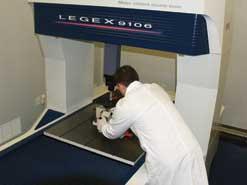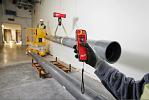- FMA
- The Fabricator
- FABTECH
- Canadian Metalworking
In-house or outsource?
- June 10, 2010
- News Release
- Measurement
Many companies have faced the decision of calibrating tools in-house or outsourcing. There isn’t one simple answer, because every company has different needs. Some have gauge lists that look like a precision tool catalog and others have only a half dozen tools that need to be calibrated. What steps should you follow in making this decision?
First, what inspections can you actually do in-house? Perhaps the tools or equipment that you use require a manufacturer to perform the calibration. Next, consider the pros and cons of each, in particular, annual cost, turn around, logistics, and personnel needs. Lastly, consider the “Quality Standard” which you are working to in your company. Are there any restrictions or limitations in the standard that limit your choice?
In determining what calibrations you can do in-house, take the time to review your gauge list. Your review should include investigating the national or international standards to determine what tests you should perform. Using this information, develop a list of items you will need to purchase to do the calibration. For instance, if you look at the caliper standard, you will learn that, among other things, you will need to inspect the measuring length at different intervals for both the external and internal measuring jaws. To do this, you will need, at a minimum, a set of gauge blocks that cover the full measuring length. Or you may want to consider a “caliper-checking gauge.” These devices have stacks of gauge blocks or other precision surfaces that are incrementally stacked to allow quick checks of both external and internal jaws, normally in a range up to 12 in. (300 mm).
Next, you must look at your facility to locate a permanent location in which you can perform the tasks required. You must consider temperature, humidity, and vibration sources. The temperature and humidity should be monitored throughout the year to confirm that from day to day, season-to-season, there isn’t a significant shift in temperature. Significant temperature shifts of even 1 or 2˚C can effect the measurements that you make.
Now you should review your personnel to see if you currently have someone who is “qualified” to do the inspections. This person may have formal education in metrology, but more than likely will be one who, through experience and knowledge of measuring instruments, is deemed to be capable.
There are other things to consider for in-house calibration but the three items mentioned above are typically the most significant. In your evaluation be sure you perform a cost analysis. If you need to control temperature and humidity better than it is now, this will likely be a significant cost. You must also consider that floor space, even that area in the corner of the lab, because it will be a cost to the company. One of the most overlooked aspects of the cost assessment is the labour portion. The person selected to perform calibrations may also perform other work as well, therefore time spent on all activities must be accounted for to get a true picture of the cost for calibration.
Once these steps have been completed, you can then evaluate commercial calibration laboratories to determine how outsourcing compares to in-house calibration.
The review of commercial calibration laboratories can be far easier than reviewing your own facility. These facilities have usually made substantial investments in equipment, environment, and personnel to provide services to you and other companies. These factors however, while important, are not the only things that need to be considered when assessing the capabilities of a laboratory.
Automotive parts manufacturers should be aware of the ISO/IEC 17025 standard, which is the “General Requirement for the Competence of Testing and Calibration Laboratories.” This standard provides detailed requirements for facilities involved in calibration and testing. One of the most significant aspects of ISO/IEC 17025 is the requirement of the laboratories or testing facilities to have a “scope of accreditation” with stated uncertainties. The scope is to cover only the work for which they are accredited and potential customers of these laboratories or facilities must request a copy prior to issuing any contracts. The scope will provide details regarding the products for which the accreditation applies, and will state the “best measurement uncertainty” achievable (remember this is the “best measurement uncertainty” not necessarily their day-to-day achievement). Some customers who have not been diligent have assumed that because laboratory “A” was accredited to calibrate gauge blocks, they must be accredited for all measuring tools. This is a bad assumption as most facilities apply for only one or two product areas at a time, and add to their scope as time goes on. Another assumption that is commonly made is that accreditation means qualified. This would depend on your needs and expectations. For instance, if your 0 to 1 in. micrometer needs to be calibrated, and you want the accuracy verified to +/-0.0001 in., the laboratory must work with a measurement uncertainty of less than this value for this particular tool. This is because the measurement uncertainty must be considered when calculating the results of the calibration. As an example, suppose the laboratory’s “best measurement uncertainty” for testing 0 to 1 in. micrometers is +/-0.001 in., this value must be calculated into the test results. This means that if the indicated error at 1 in. is +0.0001 in. then the real value could be anywhere between +0.0011 and –0.0009 in. Would this be acceptable for your purposes?
When you are reviewing the measurement uncertainty statements of any laboratory, do a little homework on your own to ensure that the values are reasonable. If for instance, a laboratory or testing facility claim an uncertainty equal to or better than the best capability of a National Laboratory (NRC in Canada, NIST in the USA), you may want to know more about their evaluation methods.
Another important consideration is the capability or authority of the accrediting body. The ISO/IEC 17025 standard requires that the accrediting body “enter into mutual recognition agreements with equivalent bodies in other countries. Accrediting bodies such as Calibration Laboratory Assessment Service (CLAS) in Canada and A2LA in the US are examples of organizations that comply with the standard.
This leads us back to the question of “what should you do?” Well once you have completed your analysis of the two methods for your own circumstances, hopefully you will have gained enough knowledge to make the right choice. QC
Peter Detmers is the sales and service manager at Mitutoyo Canada, Mississuaga, ON.
subscribe now


Keep up to date with the latest news, events, and technology for all things metal from our pair of monthly magazines written specifically for Canadian manufacturers!
Start Your Free Subscription- Industry Events
MME Winnipeg
- April 30, 2024
- Winnipeg, ON Canada
CTMA Economic Uncertainty: Helping You Navigate Windsor Seminar
- April 30, 2024
- Windsor, ON Canada
CTMA Economic Uncertainty: Helping You Navigate Kitchener Seminar
- May 2, 2024
- Kitchener, ON Canada
Automate 2024
- May 6 - 9, 2024
- Chicago, IL
ANCA Open House
- May 7 - 8, 2024
- Wixom, MI





















